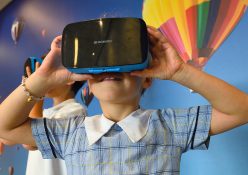As parents, we only want the best for our little ones. But what is the ideal way to stimulate them?
The concept of ‘early stimulation’ can often be a somewhat daunting expectation for those doing their best just to survive and adapt to all the demands of parenthood. We often get too caught up in what we or other people think and expect. We tend to replace playfulness with responsibility, and that burden can take the joy out of our interactions with our precious tots.
All you need is love
Research shows that several enriching time periods, in particular the first three years of one’s life, produce a multitude of nerve connections in the brain. What expands the brain’s wiring is the flood of sensory and motor experiences the infant receives right from birth. Being smiled at, watching a mobile, listening to Mom or Dad’s voice or being lovingly touched, cuddled and played with all send out electrical impulses that build and refine the brain’s circuitry. All of this points strongly to the importance of hands-on parenting and providing babies with a healthy dose of enjoyable play experiences.
Make it part of your day
It’s empowering for parents to have a concept of what play activities they can incorporate into their daily routines to interact with their baby. Activities that stimulate their vision, hearing, touch and movement can all help them to make sense of their world and begin to move towards it.
It’s important for you to spend time watching what your baby is doing and also what they take a special interest in, and then repeating it, providing them with more of the same.
Daily interactions with a supportive caregiver are where Baby receives the most valuable input. Feeding, bathing, dressing and nappy-changing provide some wonderful opportunities for good playful interaction.
Outside stimulation
Baby clinics, family or friend groups, and mother-baby workshops are also very beneficial to our learning process as parents. Groups provide support and sharing and help parents to understand their baby’s behaviours, along with all the stages of development and the activities that are best for stimulating motor and sensory development.
Too much, too soon?
When talking about stimulation, though, we as parents should keep in mind that ‘the more the better’ is not necessarily the correct strategy. We need to learn how to gauge our baby’s readiness and responses and become attuned to their needs.
Your baby should be ready for human interaction so they can properly benefit from stimulation. When calm and alert, they are receptive and will benefit the most from your playful times together. Younger babies spend shorter periods in this optimal state, whereas older ones can progressively deal with a bit more stimulation for longer periods of time.
It’s immensely powerful when parents feel the thrill of being able to calm their baby, and hold a space for interaction and positive emotion. From this solid platform, your baby is able to view the world with curiosity, a start from which exploration and learning emerge.
Individual needs
Each child has their own unique sensory processing style, an individual way of perceiving and thus experiencing their world. We need to recognise our babies’ style and how they process their world.
Some babies are more sensitive. For these parents, it’s not so easy to do just anything, any time, any way. Often these babies become easily overwhelmed and can become noticeably anxious in new environments and also with new people. They may need assistance from a parent who can help them regulate and regain an organised state.
Helping your child reach a calm state creates trust and a sense of security, in turn producing a base from which your child can explore their environment and experience new social interactions.
Touchy-feely
Like the rest of us, babies experience their world through their various senses. So an understanding of their responses to sensory input helps you understand them better. Being aware of the sensory environment and the numerous effects it has on your baby helps you adapt the sensory input to suit your baby. Are the lights too bright? Is there too much noise or movement for the baby? Too many people? Are they tired of being touched and passed around? Has the baby had too busy a day? Also remember that every baby has their own tolerance level to stimulation.
Mommy and Daddy know best
Stimulating your baby is about tuning into their many individual needs, and responding to their readiness to engage with you along with the world around them. Offering the ‘just right’ type and intensity of stimulation when your baby is ready plays a significant role in your bonding and is also important for their emotional and intellectual development.
Stimulation is all about ensuring that you provide your child with playful, loving interactions during your everyday activities. Finding time to be with your baby, to watch them and to have fun together, is the key to stimulating their development. And this surely must be one of the best things we can do for our babies.
Words: Kate Bailey| Photography: Unsplash





